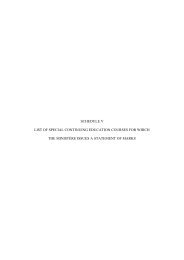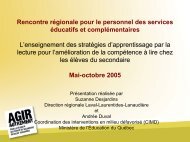Reference Framework for Planning Learning and Evaluation Activities
Reference Framework for Planning Learning and Evaluation Activities
Reference Framework for Planning Learning and Evaluation Activities
Create successful ePaper yourself
Turn your PDF publications into a flip-book with our unique Google optimized e-Paper software.
Practice<br />
• Appropriation of learning<br />
through application in<br />
meaningful tasks or<br />
activities<br />
• Gradual practice of the<br />
various steps involved in<br />
the competency<br />
Practice<br />
Over the course of their learning, students are required to establish<br />
relationships between the different elements of the competency <strong>and</strong> to<br />
situate the competency in its context. The teacher presents the<br />
competency in a variety of situations, describing working conditions.<br />
These situations allow the students to integrate their learning <strong>and</strong> to<br />
practise in order to anchor their knowledge <strong>and</strong> consolidate their<br />
learning.<br />
Practical exercises associated with the per<strong>for</strong>mance of certain occupational operations can help<br />
develop <strong>and</strong> refine skills. In addition, they foster the use of knowledge <strong>and</strong> know-how in situations at<br />
the same level of difficulty. As students develop the competency, they could, <strong>for</strong> example, be put in<br />
situations involving problem solving, 21 the use of new learning in conjunction with knowledge <strong>and</strong><br />
know-how they have mastered, or repeated or increasingly complex actions. The teacher reviews the<br />
learning <strong>and</strong> provides students with additional in<strong>for</strong>mation, asks questions <strong>and</strong> proposes corrective<br />
measures <strong>and</strong> strategies <strong>for</strong> analysis. In an ef<strong>for</strong>t to help the students learn, he or she supports their<br />
progress, evaluates them <strong>and</strong> in<strong>for</strong>ms them of their results. The in<strong>for</strong>mation gathered enables the<br />
teacher to evaluate results <strong>and</strong> to regulate his or her teaching <strong>and</strong> the students’ work. Knowledge of<br />
their results can sustain students’ level of interest <strong>and</strong> encourage them to make an ef<strong>for</strong>t.<br />
The use of knowledge <strong>and</strong> know-how in meaningful tasks or activities is as important here as in the<br />
exploration phase. Moving back <strong>and</strong> <strong>for</strong>th between what has been learned <strong>and</strong> what is still to be<br />
learned facilitates the transfer of learning. In this phase, activities can involve role-plays, repetition,<br />
teamwork, presentations using different technologies, etc., <strong>and</strong> usually take place in the workshop, at a<br />
workstation or in the laboratory, depending on the trade or occupation in question.<br />
21. Problem solving could have been introduced in the exploration phase. There is no key moment <strong>for</strong> presenting problems<br />
closely related to those encountered in the workplace. However, the level of difficulty of the problem may increase as the<br />
competency is developed. It all depends on whether a simple, complex, general or specific approach is used.<br />
<strong>Planning</strong> <strong>Activities</strong> to Help Students Acquire Competencies 35




